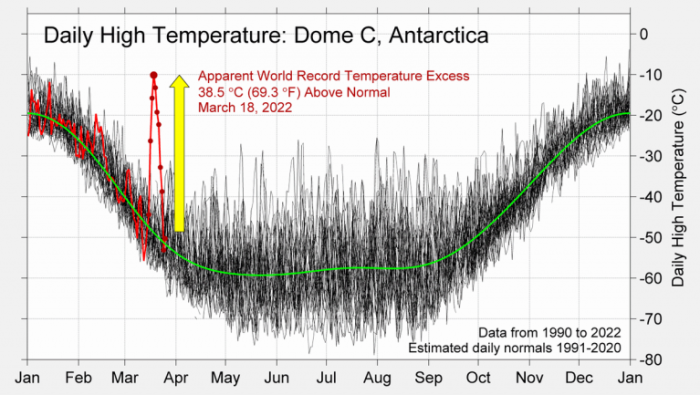- Two record-breaking heatwaves occurred simultaneously in the Antarctic and Arctic.
- Temperatures reached about 40°C above normal.

Beginning on the 15th of March 2022, two record breaking heatwaves occurred simultaneously in the Antarctic and Arctic. For both poles to display such heating at the same time was both unprecedented and unexpected.
The two heatwaves were not synoptically linked but both were related to similar weather patterns involving warm and moist air being transported surprisingly close to the poles.
In the Southern Hemisphere, a band of westerly winds around Antarctica usually isolates the continent from other weather systems. During the heatwave event, a strong atmospheric river of warm and moist air originating in the mid-latitudes was pumped from near Tasmania and South Australia, breaching the westerly winds. The warm air became trapped over East Antarctica by a blocking high pressure system for a few days. Cloud cover over the Antarctic ice plateau also reduced the amount of heat radiating away from the land. In East Antarctica, temperatures during this heatwave reached ~40°C above normal over large areas of the plateau for a few days.

On March 16th, the Australian coastal station Casey reached 5.6°C, marking a new March maximum temperature that was warm enough to melt ice.
The East Antarctic heatwave drove the overall Antarctic continental average temperature to about 5°C warmer than normal on the 17th of March. The Italian French research station Concordia reached its highest observed temperature for any month of -11.8°C on March 18th, in stark contrast to the usual -50°C March temperatures there.
We cannot yet attribute this heatwave in Antarctica to climate change This does not mean that this heatwave was not linked to climate change. Rather, it means that we will need a longer time record to be able to identify a climate change signal in Antarctic extreme events.

Main research contact: Professor Julie Arblaster julie.arblaster@monash.edu
The State of Weather and Climate Extremes 2022
Weather and climate extremes in Antarctica
Extreme events in 2022
Heatwaves in Western Australia
Extreme rainfall and flooding in Queensland and New South Wales February-March 2022
Record low Antarctic sea ice extent in 2022
Simultaneous Antarctic and Arctic heatwaves
Collapse of East Antarctic Conger ice shelf
Hailstorms in Queensland, Victoria and New South Wales
Damaging wind gusts in South Australia and the Northern Territory
© 2023 ARC Centre of Excellence for Climate Extremes
References and acknowledgements available in the PDF version available here.
Materials used are for educational purposes and either author provided or used under fair dealing provisions.
